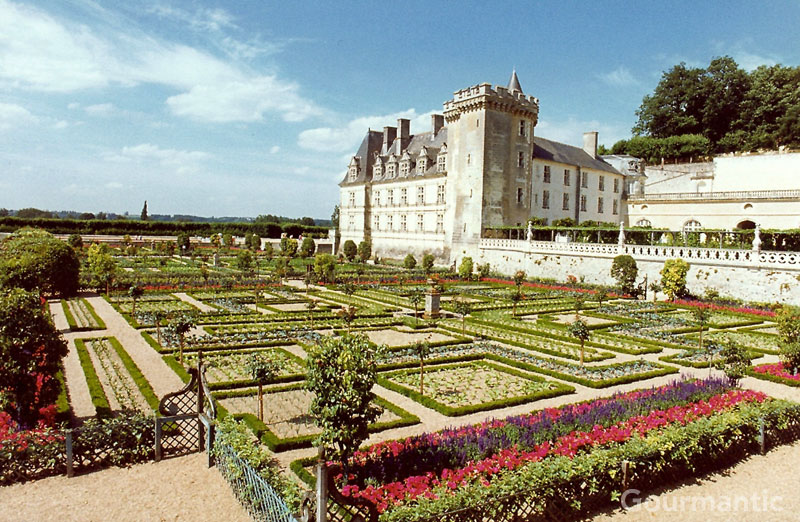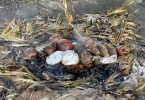The exit from La Rochelle is surprisingly smooth once we clear the train station and get onto the RN11. The reason being, we are following Cousine G in her car! We soon part ways and join the N137 that takes us past Marans where we later get onto the N160 to Angers.
The landscape is changing again. We drive past vineyards, large open fields, woodlands with the odd château in the distance. We arrive in Angers, famous for tapestries including that of the Apocalypse woven in the fourteenth century, with illustrations from the Book of Revelations. The reason for our brief stop is to tour the premises of Cointreau on rue Croix Blanche. Needless to say we have a lot of difficulties finding it.
 Arrowed signs never point to the direction they are meant to convey. When an arrow points to the right at a slight angle, it can also mean straight ahead. So when we take the right turn, we get lost through another jumble of arrows and try to return to the initial location with difficulty. Arrows can also point in two directions and lead to the same town without any further signage. By the time we figure out these rules, we will be in Paris!
Arrowed signs never point to the direction they are meant to convey. When an arrow points to the right at a slight angle, it can also mean straight ahead. So when we take the right turn, we get lost through another jumble of arrows and try to return to the initial location with difficulty. Arrows can also point in two directions and lead to the same town without any further signage. By the time we figure out these rules, we will be in Paris!
 Not all road signs are confusing. Most conform to the international system and are easily understood. A picture of a stag indicates stag crossing, arrows in a circle are roundabouts, a red diagonal line across the name of a town means the end of it. Then there is Mr G’s favourite, two joined semi-circular mounds indicating a pair of breasts ahead.
Not all road signs are confusing. Most conform to the international system and are easily understood. A picture of a stag indicates stag crossing, arrows in a circle are roundabouts, a red diagonal line across the name of a town means the end of it. Then there is Mr G’s favourite, two joined semi-circular mounds indicating a pair of breasts ahead.
We find a map of Angers on a side street but it doesn’t leave us any wiser. There is no sign indicating, “vous etes ici”, and the road is not sign posted! We abandon the idea of visiting Cointreau and continue in the direction of Tours.
Stop Over in Vivy
Our rumbling bellies indicate lunchtime. We find ourselves in the tiny village of Vivy. Determined not to waste time looking for food, we stop in front of a boulangerie patisserie and indulge in a tarte aux fraises, tarte au citron and an éclair au chocolat. We sit on the other side of the road, near the town hall and savour the delicacies under the sun. Convenient toilettes are located nearby. We take a little walk in the village to stretch our legs before continuing en route along the N147.
La Loire
The Loire Valley is firmly rooted in history and boasts glorious Châteaux ranging from Medieval feudal fortresses to the more elegant stately homes and stands on France’s longest river, La Loire. Chenonceau, Amboise, Ussé and Chambord are only a few names belonging to the array of the Châteaux that entice the visitor.
Much like our previous efforts at taking in the sights, we soon realise that we are short of time.
We find ourselves on the banks of the Loire with Château de Saumur in sight, unsure of which direction to take. The late fourteenth century Saumur is a fortress standing high above the Loire and home of France’s elite equestrian order, Le Cadre Noir. The chateau was used as a Protestant stronghold in the seventeenth century, a prison in the eighteenth century, barracks during the nineteenth century, then in the early twentieth century Musée d’Arts Décoratifs then Musée du Cheval.
With the aid of a map purchased from the tourist office, we realise that we cannot visit more than three Châteaux. We have underestimated the distance to Orléans, our stop for the night. We cross the Loire and continue on the road hugging the river. With the tranquil and picturesque scenery before us, we wish we had at least three days to see the magnificent region rightly named La Vallée des Rois, the valley of the kings.
Ussé or Sleeping Beauty’s Château

We cross the Loire again to join the D947 then onto the narrow D7 to Ussé. Belonging to a marquis, the Château was built in the fifteenth century. The whitish stone and romantic turrets set against the darkness of Foret de Chinon inspired the seventeenth century writer, Charles Perrault with Sleeping Beauty’s.

We take a little respite along the banks of the Indre in a café aptly named Au Bois Dormant. A pop-up menu offers a cocktail of glaces or ice creams, named after characters from the fairy tale. In the tranquility of the Indre Valley, we share an ornate serving of La Bonne Fee and an icy cold Perrier.
Azay-le-Rideau

Our next stop is a brief visit to Azay-le-Rideau, the most beautiful Château of the early Renaissance, built partly over the Indre with exquisite gardens. It is named after one of its Lords, Rideau d’Azay who was knighted by Philippe Auguste and built a Château. In 1418, it was the site of a tragic massacre. When the Dauphin was insulted by a guard as he passed through Azay, he retaliated, seized and burnt the town and executed the captain and his soldiers hence it was named Azay-le-Brulé until the eighteenth century.

Time is not on our side for a visit so we settle on the souvenir shop around the car park for a brief opportunity to browse at Château memorabilia.
Villandry and the Spectacular Gardens
On to the D7, we head towards Villandry, a short drive away. Built in 1536 by a minister of Francois 1e, Villandry was the last of the Renaissance Châteaux to be built on the Loire. In 1906, it was bought by Dr Joachim Carvallo who was born in Spain and was the present owner’s grandfather. Consequently, the Château is decorated with Spanish furniture and Goya paintings but most visitors are mainly interested in its unique jardins.

The gardens consist of three terraces one above the other. Upon leaving the fore courts, we see the kitchen garden, le potager. Located between the Château and the village, it consists of nine squares with identical borders but different internal geometrical designs, formed by alternating coloured vegetables. There are many roses which provide ornamental colours. The area between the vegetable garden and the church is occupied by a herb garden with over thirty species of aromatic and medicinal plants.

Above the kitchen garden lies the ornamental garden or le jardin d’ornament. In the first boxwood salon, there are four squares representing various aspects of love.
1 – Tragic Love or L’Amour Tragique is represented by blades of swords and daggers used if duels over various women. In summer, the red flowers symbolise blood spilt during such battles.
2 – Fickle Love, L’Amour Volage, is represented by four fans in the corners denoting the inconsistency of emotions. Between them are horns of betrayed love and in the centre are love letters sent by a fickle woman to her lover. These remain innocently white whereby the dominant colour of the square is yellow and has been so since the Renaissance.
3 – Tender Love, L’Amour Tendre is symbolised by hearts. In the centre, masks worn during dances which initialled conversations are represented.
4 – Crazed Love, L’Amour Folie also contains hearts but broken by passion. A Maltese Cross, Languedoc-Basque crosses and Fleur de Lys designs feature in the middle left.

The second boxwood salon is a garden symbolising music with its large triangles representing lyres, harps and musical scores.

Above the ornamental garden is the water garden or Le Jardin d’Eau, centred around a large expanse of water in the shape of Louis XV mirror, surrounded by lush greenery, an ideal spot to rest in the heat.

We walk up to the terrace behind the Château for a panoramic view of the gardens which are impossible to photograph in one frame. The Château, surrounded by white swans in the adjacent waters appeared a little indifferent in comparison. Such beauty evokes the imagination roam and releases a burst of creativity.
We take the D7 road to Tours then the long N152, a slow pictorial riverside ride to Orleans. The Touraine landscape that extends before us reminds me of Balzac‘s narratives in Le Lys dans la Vallee and Eugenie Grandet.
… continues tomorrow
‘Le Tour de France Gourmantic’ series is the story of a young couple from Australia who took to the French roads on a whirlwind Tour of France back when the internet wasn’t at everyone’s fingertips, phones were still attached to sockets, GPS was an unfamiliar acronym, digital cameras were a pipe dream and the Euro hadn’t replaced French Francs. With just one fold-out map of France and boundless enthusiasm, they took their Renault 19 and went on a cultural and culinary discovery.






[…] This post was mentioned on Twitter by Ms Gourmantic, Ms Gourmantic. Ms Gourmantic said: Le Tour de France is nearing the end and so is ours as we spend one day visiting Châteaux de la Loire http://bit.ly/acCmd2 #tdf #france […]
[…] the Chateaux de la Loire behind us and the sun at oblique angle, we soon reach Hotel Terminus in Orléans sans […]